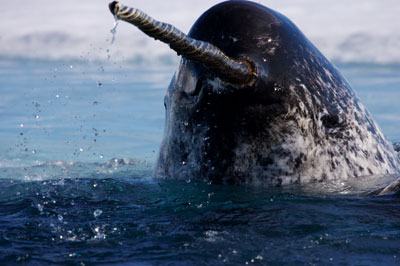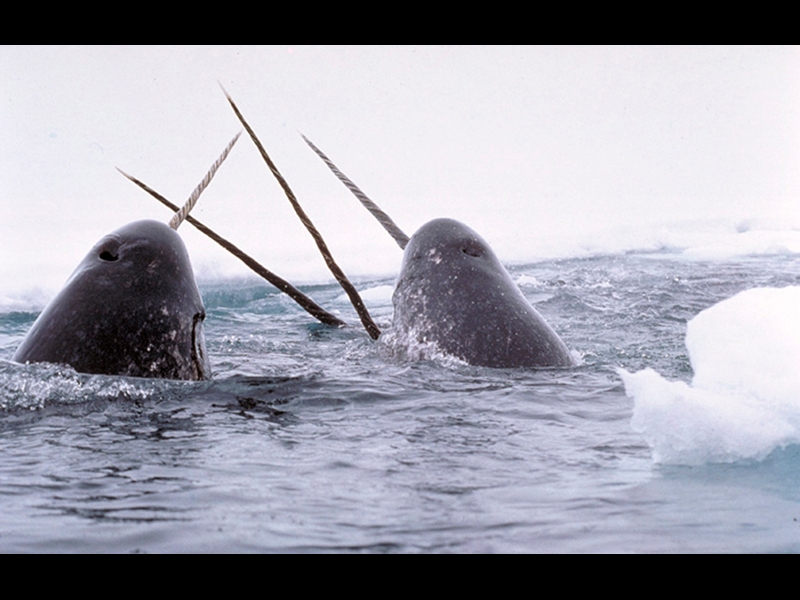Unicorns of the sea
Unlike its mystical counterpart commonly found in fairy tales and on girly bedsheets, these marine mammals indeed do exist.
 (Image by Paul Nicklen/National Geographic)
(Image by Paul Nicklen/National Geographic)
The Narwhal (scientific name Monodon monoceros) is a toothed whale, or odontoceti, predominantly found in the Arctic Ocean. Ironically, its scientific name that means “one-horn, one-tooth” is inaccurate.
This amazing animal actually has two teeth and no horns. Most male Narwhals (and minority of females) have a single spiral tusk, which is essentially a long and sharp tooth that projects from the left side of their upper jaw. These tusks can reach lengths of up to nine feet (2.5m) long, which is more than half the length of a fully-grown male.

Narwhal alone (Image by Paul Nicklen, National Geographic)
With a long tusk like that, you’d think that it would be meant for spearing their enemies. Making kebabs.
Guess not.
Unlike our teeth, whereby the pulp containing blood and nerves in encased by the hard enamel, the Narwhal’s tusk has the soft, sensitive part on the outside. This serves as a sensor to detect change in water pressure temperature and salinity, and possibly barometric pressure when it is above water. (Lambert, 2008)
 Close-up of a Narwhal’s tusk (Image by Paul Nicklen/National Geographic)
Close-up of a Narwhal’s tusk (Image by Paul Nicklen/National Geographic)
Since only males are likely to have this distinctive characteristic, it is possible that the legendary tusk is used to impress females. Narwhals make use of it to determine their social rank, and compete for the best mate. (Connor, et al., 2000)
 Males jousting for a mate (Image by Paul Nicklen/National Geographic)
Males jousting for a mate (Image by Paul Nicklen/National Geographic)
Narwhals have been sighted crossing their tusks and making a strange, sad whistle with a female between them. This form of behavior could be attributed to the maintenance of the male’s dominance in their hierarchical social structure.
 Narwhals fencing (Image by Glenn Williams, Britannica Blog)
Narwhals fencing (Image by Glenn Williams, Britannica Blog)
Fights have been known to get rather violent, with broken tusks, tusk tips embedded in skulls and significant head scarring. Generally, the larger males with heavier (not longer) tusks tend to suffer more scarring. It may be an indication that the stronger and sexually mature males engage more frequently in aggressive fights. Females and young males are less prone to head scarring. (Gerson and Hickie, 1985)
Here is a link to a video showing the fencing behavior exhibited by narwhals.
Fencing Whales (BBC Two, 2011)
All in all, Narwhals are pretty fascinating creatures. And now we know their tusks aren’t really meant for skewering.
References
Journals
Gerson, H. and Hickie, J., 1985. Head scarring on male narwhals (Monodon monoceros): Evidence for aggressive tusk use. Canadian Journal of Zoology, 1985, 63(9): 2083-208
Mann, J., Connor, R., Tyack, P. and Whitehead H., 2000. Male reproductive strategies and social bonds. Cetacean Societies: Field Studies of Dolphins and Whales. pp 247-249
Silverman, H. B. and Dunbar, M. J., 1980. Aggressive tusk use by the narwhal (Monodon monoceros L.). Nature 284, 1980, pp. 57-58
Research Articles
“How Narwhals Work” by Lambert, K. HowStuffWorks, 18 Aug 2008. URL: http://science.howstuffworks.com/zoology/marine-life/narwhal3.htm (accessed on 3 Apr 2013).
Images and Videos
“Arctic Animal Pictures”, Animal Planet. URL: http://animal.discovery.com/animal-facts/arctic-animal-pictures.htm (accessed on 3 Apr 2013).
“Fencing Whales”, BBC Two, 11 Aug 2011. URL: http://www.bbc.co.uk/programmes/p00l3kk6 (accessed on 4 Apr 2013).
“Hunting Narwhals” by Nicklen, P., National Geographic, Aug 2007. URL: http://ngm.nationalgeographic.com/2007/08/hunting-narwhals/nicklen-photography (accessed 5 Apr 2013)
“The Legend and Mystery of the Narwhal” by Rogers, K. Britannica BLOG, 16 Mar 2011. URL: http://www.britannica.com/blogs/2011/03/legend-mystery-narwhal/ (accessed 5 Apr 2013)